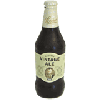Coopers Brewery Limited - Coopers Vintage Ale (2008)
-
ABV:
7.50% -
Serving Temperature:
50-55° F -
Suggested Glassware:
Pint Glass, Snifter or Stein
Naturally carbonated in the bottle, this beer has a fine sedimentary layer that you may or may not want to disturb when pouring. Purely a matter of preference, you can pour the beer gently and leave a bit of the beer behind in the bottle to minimize introduction of this sediment, or, swirl the bottle about halfway through the pour to kick it up and pour into your glass. Typically, if it’s a pale beer that is very “pretty” to look at, served in a glass where the sparkle and rising carbonation jets are part of the appeal, we favor leaving the sediment behind. But in a darker beer like this, and especially in stronger, limited vintage brews, we like to get every last drop. It’s your call—try it both ways to find out what you prefer (keep in mind, the decision “to rouse or not to rouse” is not entirely one driven by visual aesthetics; the yeast can have an effect on the aroma and flavor of the beer. Luckily, we send more than one bottle of each of our featured beers, so you can easily try both ways and decide for yourself). Coopers Vintage Ale is brewed just once a year and is always labeled with its year of vintage. The 2008 vintage is still a bit “young”, though already over a year in age. If you look closely at the printing on the bottle itself, instead of a “Best Before” date you’ll find a “Best After” date. Why? Because this very sturdy beer was designed to be matured; when kept at cellar temperatures (low-mid 50s) the beer will age gracefully for years to come. The oldest Coopers Vintage Ale we’ve had was 4 years old and it was still magnificent, so be sure to stash a bottle or two away for at least a year. Take detailed tasting notes this time around so you can compare how the beer has developed when you wake it from its slumber in 2010 or later. On the nose, look for notes of apple skins, peaches, apricots, clementines, honey with nutty, yeasty, caramel nuances, figs, gingerbread and floral complexities. Hops are overwhelmed by the maltiness, but they’re there if you look for them (you may pick them up as more of a tingle or spice in the nose). The flavor profile is front-loaded with caramel, under-ripened apples, red grapes, cereal grains and floral notes. But all of these sweeter notes are quickly dried up as the hops kick in with a balancing, stemmy woodiness and very earthy drying effect. As it warms, the beer develops a prominent Kentucky Straight Bourbon Whiskey-like note in the aftertaste. Quite nicely done—this is another stellar “cellar” vintage! A fine cigar beer to be paired with a rich, oily maduro cigar (speaking of cigars, check out www.cigarmonthclub.com for info on our Premium Cigar of the Month Club).
The Coopers Brewery was founded in 1862 just outside Adelaide, Australia, in the town of Leabrook. This respectable outfit is the last stronghold of the historic family-owned breweries on the Australian continent. Thomas Cooper, a Wesleyan preacher from Yorkshire, England, immigrated to southern Australia and founded the brewery at a time when big breweries dominated the local colonies. Unfortunately, that fact hasn’t changed much in Australia, and the Coopers Brewery had faced multiple threats of hostile takeover from the big boys.
Thomas Cooper’s brewing career was initiated much by accident when his ailing wife requested that he make a restorative ale—from an old family recipe—to be used as a tonic. Turns out the ale was well received not only by his wife, but by locals for whom he provided samples. Appreciated for its taste and perceived medicinal attributes, demand grew enough for Cooper to start his famous brewery, which today remains as the sole independent brewery in Australia to survive the entire 20th century.
Interestingly, as a Wesleyan preacher, Thomas Cooper felt that pubs were sinful places (though he wisely saw no evil in beer—after all, it was the tonic that aided his wife's health). Thus, for most of its history, the brewery owned no pubs, and today they own only one, the Earl of Aberdeen, in the old center of Adelaide. A brewery with no pubs, while commonplace in the US microbrewery revolution, is a very rare scenario for established overseas breweries. This apparent lack of an "automatic market" seems to have been critical in avoiding takeover bids during their history. And we like to believe that Thomas Cooper would have been a fan of our beer of the month clubs for this very reason—no pub necessary to enjoy these fine brews, right?
We're major fans of Coopers and their true-to-style beers, and admire them for sticking to their goal of being a family-based business. Back in 2005, a competing brewery (a conglomerate really), had launched a hostile takeover bid. Coopers, while family-run, does have shareholders, and if a majority of them approved the deal, it would have been adios to independence. Thankfully, the Coopers family (and their shareholders) were ready for the fight, rejected all bids, and have proudly maintained their independence as a family-owned and operated brewery. Join us in lifting a pint to their continued independence!
For more information about the brewery, check out their website at www.coopers.com.au

Unmatched Variety by style, brewery & country
Choose from Five different Beer Clubs offering unmatched variety by brewery,
country of origin, and beer style to suit your specific tastes.


